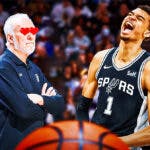With his head down, Rudy Gay walked into the locker room, sulking. On this night–November 11th, 2013, his Toronto Raptors fell to the Houston Rockets in two overtimes, 110-1-4. Down 106-104 with 1:13 during the second overtime period, Gay missed a jumper which resulted in a Jeremy Lin floater with 33 seconds remaining.
Gay clanked another jump shot with 26 ticks left and failed to dial up a three with 15 seconds left in the game. Reminiscing on the battle he had fought, Gay laments his performance, wishing “I [Gay] would've hit the easy ones and maybe things would've worked out differently.”
Rudy Gay tallied 29 points on that night but that figure, which many fans would have unquestioningly praised back then, had a scar on it. In ESPN's box score for that night, the second column read “FG: 11-37.” Today, a player with efficiency as poor as Gay's would be excoriated, sometimes to the point where his impact is diminished. See Russell Westbrook, whose putrid shooting efficiency cloaks his true value.

Back in 2013, analytics began their assimilation into the NBA and NBA fans alike. Fans learned to merely glance at a player's scoring numbers before zoning in on their efficiency, a hallmark of the then-fledgling analytics revolution. The NBA was changing. Low-efficiency volume scorers were rapidly going out of fashion. And in 2013-14, Gay was the worst offender in the realm of shot-chucking. Despite his often gaudy scoring numbers, Gay's blindfolded shot selection was actively damaging. Rudy Gay knew this.
In a desperate attempt to rescue himself from the truth, he banned stat sheets from the Toronto Raptors' locker room. He attempted to cover his devious act under the presumption that the team should focus on wins, not numbers. And while this statement holds some truth, numbers lead to wins. Aimlessly heaving the ball at the tin can only take a team so far.
Eschewing statistics, surprise surprise, wasn't a winning formula for Toronto. Starting the '13-14 season with a 6-12 record, Gay's childish theory couldn't hide his .421 eFG% in 18 games up north. The Raptors unloaded Gay to the Sacramento Kings and finished the 2013-14 season with a 42-22 record and 48 wins, a franchise record at that time.

Unsurprisingly, this was not the first incident of Gay's sporadic shooting tendencies shackling a roster. Gay plagued the Memphis Grizzlies just one season prior. They shipped him off to Toronto in midseason. The result? 56 wins–the best mark in franchise history to this day–and a trip to the Western Conference Finals. Cutting Gay loose was addition by subtraction for these teams. Sacrificing volume scoring for efficiency is a trade any team will make. The common denominator on underachieving teams, Gay's lack of value was crystal clear.
Gay spent four seasons in Sacramento, rotting in the bowels of the NBA. His efficiency saw marginal improvement but that was largely for naught, as the Kings bottom fed in the depths of the league during Gay's sojourn there. During the Summer of 2017, Gay inked a two year, $17M deal with the San Antonio Spurs. He didn't see any improvement in that season marred by off-court drama.
2018-19 presented an opportunity for the Spurs to start something new. Their dynasty was officially dead, with Kawhi Leonard in Canada and Tony Parker in Charlotte. Featuring DeMar DeRozan, LaMarcus Aldrige and a rag-tag bunch of vets and young guns, opinions waivered on San Antonio's outlook.

Not shockingly, Gregg Popovich is holding true to himself. The Spurs' offense is still the same motion offense it has been for the past decade. Despite the three-point shot becoming ubiquitous, Pop still detests the long ball. All is as it should be and the Spurs currently sit seventh in the West with the league's sixth-best offense (112.4 ORTG).
None of the aforementioned should come as a surprise. What should come as a surprise, though, is the complete renaissance of Rudy Gay. Through his first 12 NBA seasons, Gay was one of the least efficient players in NBA history. Almost comically, Gay never reached 50% from the field or 40% from three, despite being a perennial 20 points per game scorer. A more massive black hole than the one at the center of the Milky Way, Gay posted a negative AST/TOV ratio in eight of his first 12 seasons.
Gay's shooting splits this season is nothing short of miraculous. His efficiency has skyrocketed in 2018-19 and Gay is now one of the league's most efficient offensive players. For the first time in his career, he has eclipsed the marks of 50% from the field and 40% from three. Stroking the ball from all over the floor, Gay is shooting 51.8% from the field and 43% from deep with a .599 TS%, all career bests.

Horrible defense and inefficient chucking are like burgers and fries: they mesh together well and they are rarely found apart. Gay was no exception, as his lackadaisical defensive effort and poor awareness neutered teams as much as his shot selection. Just like his efficiency, Gay's defensive play is at an all-time high. His 1.5 Defensive Player Impact Plus Minus ranks second on the Spurs.
In fact, Gay sports the eighth highest DPIPM of any listed power forward this season. Only super freaks and defensive savants lie ahead of Gay, names like Giannis Antetokounmpo, Draymond Green and Pascal Siakam.
Popovich has been able to convince Gay to expend significant effort on the defensive end and the results are evident. After all, Gay has always been a solid on-ball defender due to his 6'8″ frame. When Gay is engaged, he is a condor lurking in the paint. Spreading out his 7'3″ wingspan, Gay careens to the ball, blowing up offensive sets:
Often playing at the four, Gay's size and strength give the Spurs' defense versatility. He can switch onto some wings and guard the ball or stonewall bigs on the block:
Gay's gigantic spike in offensive efficiency is partly due to his seamless fit in the Spurs' offense. Like it has been for years, Pop's offense is built around motion, post-ups and mid-range shots. When your best two players are DeRozan and Aldrige, building an offense around the mid-range makes sense.
San Antonio shoots the second-fewest triples per game (25.1), despite draining them at by far the highest clip in the league (40.7%). In the Spurs' offense, The Great Rudini is free to do what he loves most. Isolations, post-ups and pick and rolls, most of which lead to some sort of mid-range jumper:
Gay's favorite and most deadly weapon, 28.3% of his shots are from the mid-range and he shoots 49,4% from there. As of February 19th, the only players with a higher efficiency from mid-range were Kevin Durant, Kyrie Irving, CJ McCollum, JJ Redick, and Serge Ibaka.
Probing the defense, Gay patiently dribbles to the cup, looking for his spots. Gay's strength and length make his middie tough to defend for any player:
Who do you think leads the NBA in pull-up FG%? The answer should be obvious given the article you are reading but Gay is one of the last players I would have guessed. His 53.2% clip on pull-ups (minimum three attempts per game) is far and away the best mark in the NBA, nearly six whole percent above number two, Kyrie Irving (47,5%).
His dominance creating in the mid-range harkens back to a former Spur great, George Gervin. As Iceman once was, Gay is money inside the arc, drilling the type of shots most players have eliminated from their arsenal:
This next possession is a microcosm of San Antonio's offensive tendencies as a whole. DeRozan neglects an open three at the top of the key. He penetrates and dishes to an open Gay, who neglects an open three, instead electing to shoot his bread and butter one-dribble pull-up.
This is the San Antonio Spurs' formula. Kawhi Leonard has to respect the threat of the Gay three, as he is shooting 43% on the season. The Spurs manipulate defenses with the threat of the three and the common tendencies of the time to get the mid-range shots they really want to take:
Another apparent improvement in Gay's game this season is his decision making. His 2.6/1.7 AST/TOV ratio is the second best of his career. When Gay attacks the rim or backs a defender down in the post, he is far less myopic this season.
While the errant shots and bad turnovers still exist, they are often replaced by smart passes. Harnessing his gravitational in the post, Gay finds an open Poeltl when Marc Gasol steps into his orbit:
In the past plays like that would be a turnaround jumper over two defenders. This pocket pass in a tight window would be a contested jumper over the defense:
Rudy Gay was an outcast. A casualty of the rise of analytical team building, front offices no longer had a use for a player like Gay. Gay's archetype, the no defense volume chucker, is the antithesis to the modern 3-D wing which is so coveted in today's NBA. Rudy Gay is special because he is a perfect marriage of the good of both of these archetypes.
If a team wanted him to, Rudy Gay could sit in the corner, catching and shooting every ball that comes his way. But Gay brings value in his own, unique way, going against the grain of what NBA teams value. In an era where mid-range is synonymous with inefficiency, Gay has made himself on mid-range shooting and fantastic efficiency. He frequently takes the type of shots that would get any Houston Rocket benched.
The story of Rudy Gay helps teach us to look past archetypal roles and past what analytics say a good player is. Yes, the mid-range shot will never be as prevalent as it once was. But the shot so many greats dominated and still dominate with will always have utility for an offensive player.
So next time Rudy Gay burps up a contested long two and it goes in, don't lament him not stepping back a few feet. Appreciate the fact the shot went in and the fact that Rudy Gay is relevant again. Appreciate the fact Gay is has transformed the narrative surrounding him and he didn't have to succumb to the whims of analytics to do so.




